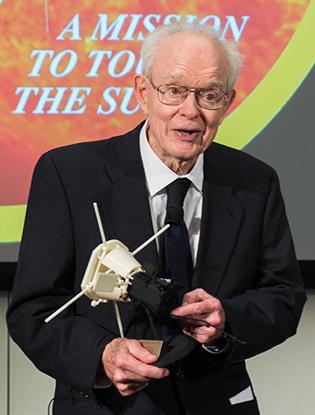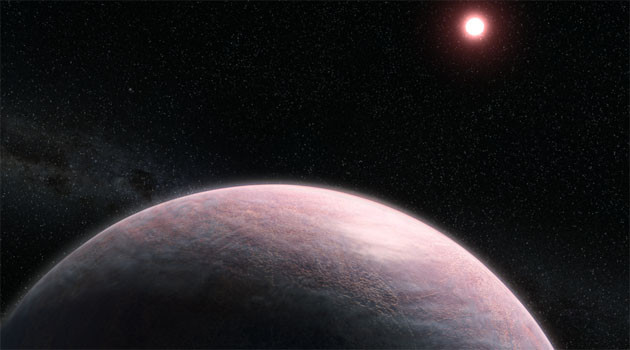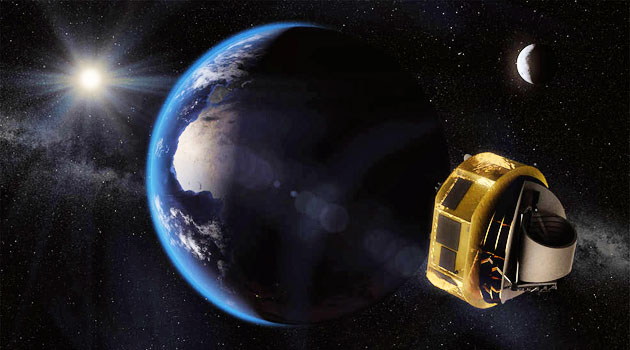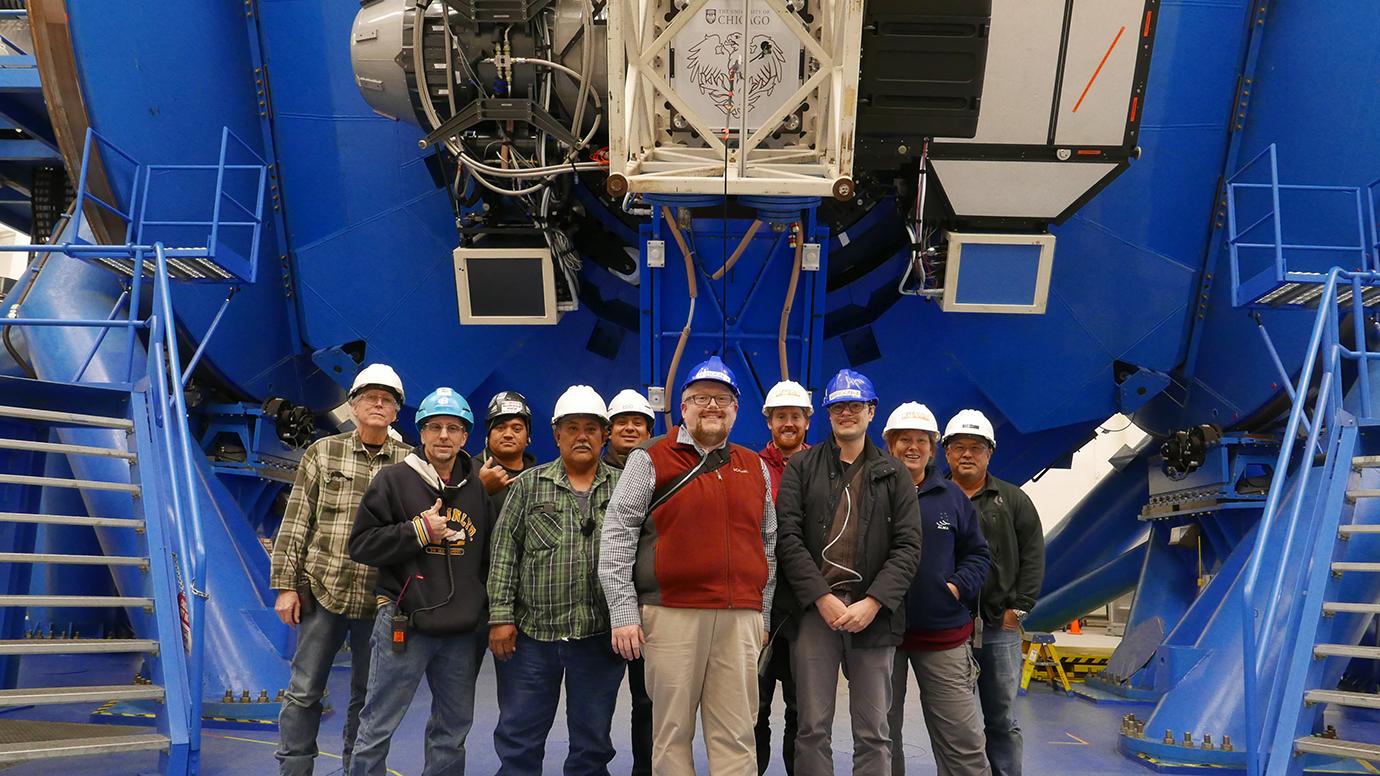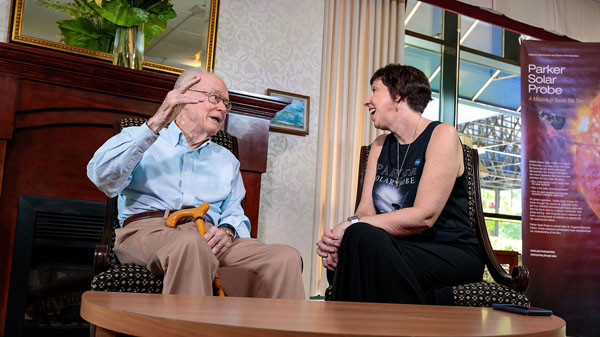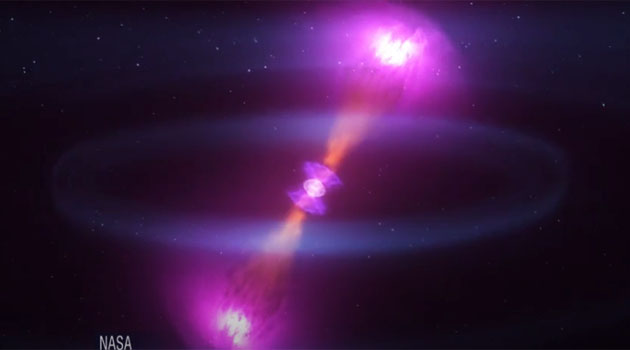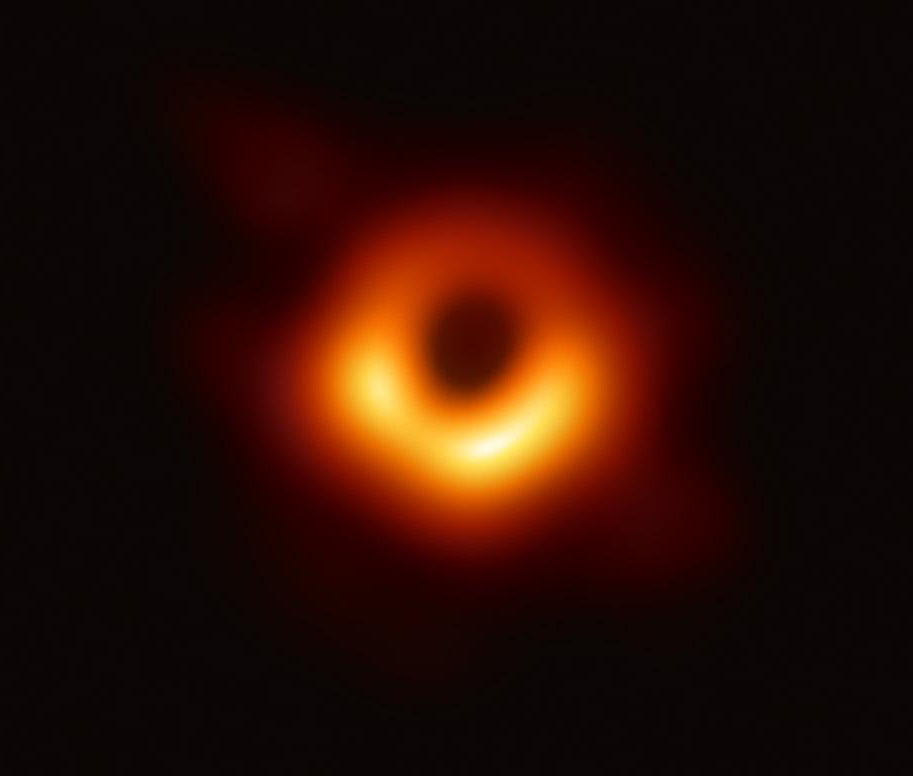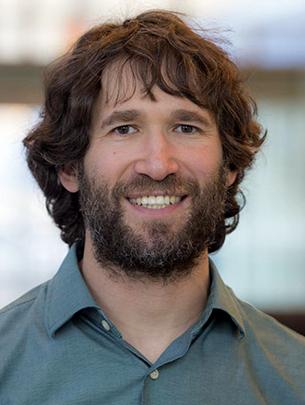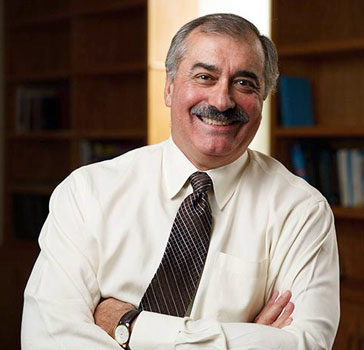 |
 |
 |
 |
 |
 |
 |
 |
 |
 |
 |
 |
|
News
|
Department in the News: 2019
Parker Solar Probes first discoveries: Odd phenomena in space weather, solar wind December 5, 2019 UChicago News NASA mission named for pioneering UChicago scientist produces landmark research Last summer, NASA's Parker Solar Probe split the predawn skies in a blaze of light as it headed closer to the sun than any other spacecraft. Named for pioneering University of Chicago astrophysicist Eugene Parker, the probe has now made three of its 24 planned passes through the sun's corona - enough for scientists to announce their first discoveries. In four papers published Dec. 4 in Nature, researchers describe strange space phenomena and a flood of new data that will help us understand everything from the nature of stars to improving our forecasting of solar storms that can affect electronics on Earth. Sidling up to the nearest star that humans can reach, the Parker Solar Probe learned new information about two types of major space weather events. It also saw the first signs of the zone around the sun where cosmic dust disappears - predicted decades ago, but never seen - as well as an entirely new phenomenon: bizarre "switchbacks" in the solar wind that flows off the surface of the sun. Scientists said it will dramatically change our theories of the corona and solar wind. Scientists are eager to learn more about the the solar wind - a flow of charged particles off the surface of the sun which radically affects the Earth and the entire solar system, which University of Chicago Professor Emeritus Eugene Parker first proposed in 1958. NASA named the solar mission after the famed astrophysicist in 2017. Related: Department members: Eugene N. Parker Astronomers Propose a Novel Method of Finding Atmospheres on Rocky Worlds December 2, 2019 This artist's impression shows a rocky exoplanet with a wispy, cloudy atmosphere orbiting a red dwarf star. Astronomers have identified a new method that could allow Webb to detect an exoplanet's atmosphere in just a few hours of observing time. NASA NewsCredits: L. Hustak and J. Olmsted (STScI) Click on the image to enlarge When NASA's James Webb Space Telescope launches in 2021, one of its most anticipated contributions to astronomy will be the study of exoplanets - planets orbiting distant stars. Among the most pressing questions in exoplanet science is: Can a small, rocky exoplanet orbiting close to a red dwarf star hold onto an atmosphere? In a series of four papers in the Astrophysical Journal, a team of astronomers proposes a new method of using Webb to determine whether a rocky exoplanet has an atmosphere. The technique, which involves measuring the planet's temperature as it passes behind its star and then comes back into view, is significantly faster than more traditional methods of atmospheric detection like transmission spectroscopy. "We find that Webb could easily infer the presence or absence of an atmosphere around a dozen known rocky exoplanets with less than 10 hours of observing time per planet," said Jacob Bean of the University of Chicago, a co-author on three of the papers. Astronomers are particularly interested in exoplanets orbiting red dwarf stars for a number of reasons. These stars, which are smaller and cooler than the Sun, are the most common type of star in our galaxy. Also, because a red dwarf is small, a planet passing in front of it will appear to block a larger fraction of the star's light than if the star were larger, like our Sun. This makes the planet orbiting a red dwarf easier to detect through this "transit" technique. Red dwarfs also produce a lot less heat than our Sun, so to enjoy habitable temperatures, a planet would need to orbit quite close to a red dwarf star. In fact, to be in the habitable zone - the area around the star where liquid water could exist on a planet's surface - the planet has to orbit much closer to the star than Mercury is to the Sun. As a result, it will transit the star more frequently, making repeated observations easier. But a planet orbiting so close to a red dwarf is subjected to harsh conditions. Young red dwarfs are very active, blasting out huge flares and plasma eruptions. The star also emits a strong wind of charged particles. All of these effects could potentially scour away a planet's atmosphere, leaving behind a bare rock. "Atmospheric loss is the number one existential threat to the habitability of planets," said Bean. Related: Department members: Jacob L. Bean NASA Instrument to Probe Planet Clouds on European Mission November 11, 2019 NASA NASA will contribute an instrument to a European space mission that will explore the atmospheres of hundreds of planets orbiting stars beyond our Sun, or exoplanets, for the first time. The instrument, called the Contribution to ARIEL Spectroscopy of Exoplanets, or CASE, adds scientific capabilities to ESA's (the European Space Agency's) Atmospheric Remote-sensing Infrared Exoplanet Large-survey, or ARIEL, mission. Prof. Jacob Bean is the science team lead for the new CASE mission. Related: Department members: Jacob L. Bean Fermilab and University of Chicago scientist Josh Frieman awarded $1 million by DOE Office of Science October 18, 2019 Fermilab, by Leah Hesla The Department of Energy has awarded Fermilab and University of Chicago scientist Josh Frieman $1 million over three years as part of the inaugural Office of Science Distinguished Scientist Fellowship program. Office of Science distinguished scientist fellows were chosen from nominations submitted by nine U.S. national laboratories. Frieman is one of only five scientists selected, chosen for his scientific leadership, engagement with the academic research community, scientific excellence and significant scientific achievement. The Distinguished Scientist Fellowship was established to develop, sustain and promote excellence in Office of Science research through collaborations between institutions of higher education and national laboratories. Frieman says he will use the funding to support his cosmic research program and to foster tighter connections in cosmic frontier research between Fermilab and the University of Chicago. Related: Department members: Joshua A. Frieman Nearly a decade in the making, exoplanet-hunting instrument installed in Hawaii October 2, 2019 MAROON-X team members and Gemini Observatory staff standing in front of the Gemini North telescope with the MAROON-X unit. (From left): Paul McBride, John Randrup, Rody Kawaihae, Harlan Uehara, and Eduardo Tapia of Gemini Observatory; MAROON-X team members Andreas Seifahrt, David Kasper and Julian Stuermer; as well as Alison Peck, and John White of Gemini Observatory. UChicago News, by Louise LernerImage courtesy of Andreas Seifahrt Click on the image to enlarge Built by UChicago scientists, MAROON-X will search for worlds in other solar systems Atop a dormant volcano in Hawaii, an extremely delicate instrument - designed to help scientists find distant worlds - is scattered across the floor in hundreds of pieces. "Imagine trying to assemble one of those huge LEGO sets, except there's no instruction book; you've done it once before, but then you had to take it all apart and put it in little bags," said Jacob Bean, associate professor of astronomy and astrophysics at the University of Chicago. "Also you're at 14,000 feet, and when the air is that thin it impairs your judgment and thinking, and so here you are working 12-hour shifts lifting heavy things but also trying to put together a delicate instrument." This was Bean's task as the head of a UChicago project to build and install an innovative instrument that will scan the skies for new exoplanets - worlds in other solar systems that could potentially host life. Over the past eight years, Bean and his team had designed and built the instrument, called MAROON-X; this summer they finally attached it to a telescope at the Gemini Observatory at the top of Mauna Kea, Hawaii. "It has been a pretty intense six months for my team to commission this instrument," said Bean, an expert in faraway worlds whose research focuses on discovering and examining potentially habitable planets in other solar systems. "But in the next 10 years we're going to learn things about habitable worlds that we'd never known before. It's going to be really transformative." However, we still have no confirmed Earth - like exoplanets with habitable surface conditions. The thing about Earth-like planets, which is why it is taking so long to be able to find and characterize them, is that they're extremely hard to see. Because these planets are circling around a star that is at least a million times brighter than they are, trying to look directly for them is like trying to see a lightning bug next to a lighthouse that is on the other side of the country. So scientists have to find indirect ways of finding them based on the effects they have on their stars. MAROON-X does this by noticing the extremely tiny gravitational tug that an exoplanet (or two, or five, or seven) exerts on its star as it orbits around it. This tug causes the star to wobble just the slightest bit in its orbit. But that's enough motion to catch it. Attached to the Gemini North telescope, MAROON-X takes all the light gathered by the 25-foot telescope and focuses it down to a spot that is the width of a human hair. Then it separates out that light into the different colors of the rainbow and reads the intensity of each band. The color of the light will change slightly as the star moves forward or back. "It's kind of like a radar gun for stars," Bean said. Several decades ago, advances in technology allowed scientists to begin detecting the very faint signatures from planets orbiting other stars in faraway solar systems. There's been an explosion of discoveries; currently, NASA lists 4,000 confirmed exoplanets and thousands more candidates. Related: Department members: Jacob L. Bean, David Kasper, Andreas Seifahrt, Julian Stuermer Scientific projects: MAROON-X: M dwarf Advanced Radial velocity Observer Of Neighboring eXoplanets Ambitious project to map the Big Bang's afterglow earns NSF funding September 30, 2019 The UChicago-led South Pole Telescope maps the leftover light from the earliest age of the universe. UChicago News, by Louise LernerPhoto by Jason Gallicchio Click on the image to enlarge UChicago-led proposal receives NSF funding for pioneering sky measurements The National Science Foundation has awarded $4 million to the University of Chicago to host the development of an ambitious multi-institutional program to map the leftover light from the Big Bang in greater detail than ever before. Called CMB-S4, the groundbreaking project will allow us to see back in time to the earliest epoch of the universe. Remnant light from this period, called the cosmic microwave background, is still visible in the skies and holds clues to many of the most pressing mysteries about the universe - from its earliest moments to how it evolved to produce the wondrous structure of galaxies, stars and planets that we see today. "The history of the universe-and the physics that govern its evolution - are encoded in the cosmic microwave background, and rigorous, precise measurements will allows us to unlock this information and will likely lead to new discoveries," said renowned UChicago cosmologist John Carlstrom, principal investigator for this initial phase of the project and co-spokesperson of the CMB-S4 collaboration, who also holds a joint appointment at Argonne National Laboratory. "These are big, big topics in physics, many of which we don't know how to get at any other way." The CMB-S4 project builds on the success of pioneering observations of the cosmic microwave background from telescopes located in the high Chilean Atacama plateau and at the South Pole, including the 10-meter diameter South Pole Telescope - an international collaboration led by Carlstrom for more than a decade. But the next phase, which is projected to see first light in the late 2020s, will provide much more sensitivity - requiring new telescopes working in concert, as well as a much larger science team. The new CMB-S4 telescopes will be deployed to the South Pole and to the Atacama Desert in Chile - two places whose cold, dry climates offer the best sky viewing on Earth. They will allow CMB-S4 to boost the precision of its map by more than an order of magnitude past the best readings we have today. The initial $4 million from the National Science Foundation will complement funding from the U.S. Department of Energy to support the design of the project. CMB-S4 will be a massive, multi-institutional effort over the next decade, with a total cost of the order of half a billion dollars. The project will involve multiple universities as well as the Department of Energy's national laboratories. The CMB-S4 collaboration consists of 200 scientists from over 70 institutions spread across 12 countries. This incredible precision will enable physicists to look for evidence of ancient gravitational waves - ripples in the fabric of space-time created by the Big Bang - as well as insights into the elusive question of how to tie the force of gravity and the theory of quantum mechanics together. It also may provide fodder for the search for dark matter, a mysterious substance that pervades the universe, but has yet to be detected directly. Astronomers will also find a trove of information about stars, galaxies and clusters in the CMB-S4 data - for example, cosmic microwave background observations from the South Pole Telescope and the Chilean Atacama Cosmology Telescope have made numerous discoveries, including record-breaking massive clusters of galaxies and ancient stellar nurseries. "The history of the universe - and the physics that govern its evolution - are encoded in the cosmic microwave background." -Prof. John Carlstrom The University of Chicago has a long history of working at the Amundsen-Scott South Pole Station, which is managed by the National Science Foundation. The design team will also work with Associated University, Inc., which will coordinate the CMB-S4 plans for Chile. "We've learned an incredible amount from measurements of the cosmic microwave background, including discoveries that have pointed the way to new physics, but we have really only begun to tap the information that's encoded there," said CMB-S4 co-spokesperson Julian Borrill from DOE's Lawrence Berkeley National Laboratory. "This will be a major leap forward for the entire physics and astronomy community." The award is being made from a new NSF program for Mid-scale Research Infrastructure. "These awards represent the first in NSF's agency-wide effort to support the mid-range infrastructure that will be invaluable to strengthening the U.S. scientific research enterprise," said Jim Ulvestad, the National Science Foundation's chief officer for research facilities. "The funded projects include an impressive collection of new design efforts and advanced instrumentation. These projects fill gaps and provide unique research capabilities for the U.S. that will engage many early-career scientists and engineers in the pursuit of groundbreaking discoveries." Related: Department members: John E. Carlstrom Scientific projects: Cosmic Microwave Background Stage 4, South Pole Telescope Eugene Parker on first year of namesake NASA mission: "It's pretty exciting stuff" August 13, 2019 A year after the launch of Parker Solar Probe, NASA scientist Nicola Fox sits down with the mission's namesake, Prof. Emeritus Eugene Parker, to discuss their findings so far. UChicago News, by Louise LernerClick on the image to enlarge Pioneering UChicago astrophysicist looks back at historic launch of solar probe Prof. Eugene Parker had never seen a NASA launch in person until Aug. 12, 2018 - when a spacecraft honoring the pioneering University of Chicago astrophysicist blazed through the predawn skies, beginning its ambitious mission to the sun. Six decades after Parker wrote a groundbreaking paper that shaped how we view the solar system, the launch of Parker Solar Probe was not only historic but also emotional for the 92-year-old scientist. "So much has gone into this launch, and then to see it all disappear slowly - fading away into the night sky, knowing it will never come back - it was a moving experience," Parker said. In the year since, Parker has been receiving updates on the NASA mission, which has already come closer to the sun than any spacecraft. Parker recently visited with Nicky Fox, director of NASA's Heliophysics Division at NASA Headquarters in Washington, at his Hyde Park apartment and learned that the spacecraft is running perfectly - and has gathered twice as much data as originally predicted. "Parker Solar Probe is blazing a trail as she orbits through the corona; she's behaving beautifully," said Fox. "We're actually very excited because we have more than twice as much data as we had expected." Parker Solar Probe has circled the sun twice thus far, and on Sept. 1 will reach its closest point to the star yet. "It's pretty exciting stuff," said Parker, who is the only living person to have a NASA mission named after them. The spacecraft, built by Johns Hopkins Applied Physics Laboratory to withstand the intense heat and radiation coming off the sun, is a marvel of engineering. It is the fastest-moving object built by humans, traveling at more than 150,000 miles per hour. It must constantly orient itself to keep its shield - a four-and-a-half inch-thick slab of carbon composite that can withstand the 2,500-degree Fahrenheit temperatures - between itself and the star. (Except for one especially tough instrument, built by UChicago alum Justin Kasper, which peeks around the edge of the craft to scoop up particles of the solar wind). Fascinating every step of the way Parker Solar Probe will come closer than any other spacecraft to the sun, seeking to understand multiple mysteries about our star - such as why the corona around the sun is actually hotter than the surface of the sun itself. "You rarely have a space mission that doesn't come up with the unexpected, and it's actually going to get more exciting as the mission goes on and crosses into regions that spacecraft have never been in before," Parker said. "It's just fascinating every step of the way." These questions have their origins in a revolutionary 1958 paper authored by Parker, which claimed that the sun was expelling waves of particles in every direction. Though the idea was roundly rejected by the scientific community at first, we now know this phenomenon, which Parker called the solar wind, shapes the entire solar system. "A lot of people don't realize that space is not just empty space - it's full of this constantly active plasma that is carrying the magnetic field from the sun towards us and forming a protective bubble around the solar system," Fox said. "When something happens on the sun, we feel the impact here on Earth, and it was all predicted by Eugene Parker." Scientists also hope to use Parker Solar Probe's observations to better predict solar flares and to understand how to protect future astronauts traveling through space who would encounter solar radiation. Early answers may lie in the 22 gigabytes of data Parker Solar Probe collected during its first two encounters with the sun, but as Parker said: "I wouldn't be surprised if the most surprising things have yet to come." Related: Department members: Eugene N. Parker New measure of Hubble constant adds to mystery about universe's expansion rate July 16, 2019 UChicago News, by Louise Lerner Prof. Wendy Freedman leads study of red giant stars for new measurement of disputed constant University of Chicago scientists have made a new measurement of how fast the universe is expanding - using an entirely different kind of star than previous endeavors. That value falls in the center of a hotly debated question in astrophysics that may call for an entirely new model of the universe. Scientists have known for almost a century that the universe is expanding, but the exact number for how fast it's going has remained stubbornly elusive. In 2001, Prof. Wendy Freedman led a team that used distant stars to make a landmark measurement of this number, called the Hubble constant - but it disagrees with another major measurement, and the tension between the two numbers has persisted even as each side makes more and more accurate readings. In a new paper to be published shortly in the Astrophysical Journal, Freedman and her team announced a new measurement of the Hubble constant using a kind of star known as a red giant. Their observations, made with NASA's Hubble Space Telescope, indicate that the expansion rate for our corner of the universe is just under 70 kilometers per second per megaparsec - slightly smaller than their previous measurement, but not alleviating the tension. "The Hubble constant is the cosmological parameter that sets the absolute scale, size and age of the universe; it is one of the most direct ways we have of quantifying how the universe evolves," said Freedman, the John and Marion Sullivan University Professor in Astronomy and Astrophysics and a world-renowned astronomer. "The discrepancy that we saw before has not gone away, but this new evidence suggests that the jury is still out on whether there is an immediate and compelling reason to believe that there is something fundamentally flawed in our current model of the universe." A number behind the theory of the universe The Hubble constant, named after pioneering astronomer and UChicago alum Edwin Hubble, underpins everything in the universe - from our estimate of when the Big Bang happened to how much dark matter exists. It helps scientists sketch out a theory of the history and structure of the universe; and conversely, if there are fault lines in that theory, an accurate measurement of the Hubble constant might lead them to it. "The Hubble constant...is one of the most direct ways we have of quantifying how the universe evolves." - Prof. Wendy Freedman Twenty years ago, the Hubble Space Telescope Key Project team, which Freedman led, announced it had measured the value using distant stars called Cepheids, which pulse at regular intervals. Their program concluded that the value of the Hubble constant for our universe was 72. As astronomers have refined their analyses and gathered new data, this number has remained fairly stable, at about 73. But more recently, scientists took a very different approach: building a model based on the rippling structure of light left over from the earliest moments of the Big Bang, which is called the Cosmic Microwave Background. If they ran a model forward in time, extrapolating from the first few moments of the universe, they reached a value of 67. That disagreement is significant - nearly 10 percent - and it has continued to solidify over time. Both camps have looked for anything that might be causing the mismatch. "Naturally, questions arise as to whether the discrepancy is coming from some aspect that astronomers don't yet understand about the stars we're measuring, or whether our cosmological model of the universe is still incomplete," Freedman said. "Or maybe both need to be improved upon." Mapping the stars A central part of the challenge in measuring the universe is that it is very difficult to accurately calculate distances to distant objects. Freedman's team originally looked at two types of stars that have reliable characteristics which allow astronomers to use them in combination as cosmological measuring sticks: Type Ia supernovae, which explode at a uniform brightness; and Cepheid variables, stars which pulse at regular intervals that can be matched to their peak brightnesses. But it's still possible that there is something about Cepheids that scientists don't yet fully understand, which could be introducing errors. Freedman's team sought to check their results by establishing a new and entirely independent path to the Hubble constant using an entirely different kind of star. Certain stars end their lives as a very luminous kind of star called a red giant. At a certain point, the star undergoes a catastrophic event called a helium flash, in which the temperature rises to about 100 million degrees and the structure of the star is rearranged, which ultimately dramatically decreases its luminosity. (This will one day happen to our own sun, which will also become a red giant). Astronomers can see the point where all the luminosities of the stars drop off, and they can use this as a way to tell distance. "Our initial thought was that if there's a problem to be resolved between the Cepheids and the Cosmic Microwave Background, then the red giant method can be the tie-breaker," said Freedman. "The principle is simple," Freedman said. "Imagine that you are standing near a street light that you know is 10 feet away. At regular intervals down the street you can seen more street lights, which get progressively dimmer the further away that they are. Knowing how far away and how bright the lamp is beside you, and then measuring how much fainter the more distant lamps appear to be, allows you to estimate the distances to each of the other lamps all down the road." Freedman's team put this into action using sensitive cameras on the Hubble Space Telescope, searching for their new cosmic lampposts. By comparing the apparent luminosities of the distant red giants with nearby ones that we've measured with other methods, and pairing these readings with those from Type Ia supernovae, Freedman and her team were able to determine how far away each of the host galaxies were. The next step is straightforward: How fast that galaxy is moving away from us is the product of its distance times the Hubble constant. Luckily, a galaxy's velocity is simple to measure - the light coming from galaxies shifts depending on how fast the galaxy is moving away from us. Their calculations gave a Hubble constant of 69.8 - straddling the two previously determined numbers. "The red giant method is independent of the Cepheids and is incredibly precise. The stars used are of lower mass, have different evolutionary histories and are located in different regions of distant galaxies," said Taylor Hoyt, a University of Chicago graduate student and co-author on the paper. But the results do not appear to strongly favor one answer over the other. "We are working at the frontier of what is currently known about cosmology," Freedman concluded. "These results suggest that we do not have the final answer yet. The burden of proof is high when claims of new physics hang in the balance, but that's what makes it exciting," she said. "Either way the conflict resolves, it is important. We either confirm our standard model of cosmology, or we learn something new about the universe." The other University of Chicago co-author was Dylan Hatt, PhD'18. Carnegie scientist Barry Madore also has a visiting appointment at UChicago. Other co-authors included scientists with the Observatories of the Carnegie Institution for Science, Princeton University, Seoul National University, Penn State, Florida Atlantic University and the Leibniz Institute for Astrophysics-Potsdam. Related: Department members: Wendy L. Freedman, Barry Madore Department students: Taylor Hoyt New Hubble Constant Measurement Adds to Mystery of Universe's Expansion Rate July 16, 2019 hubblesite.org Red Giant Stars Used as Milepost Markers In 1924, American astronomer Edwin Hubble announced that he discovered galaxies outside of our Milky Way by using the powerful new Hooker telescope perched above Los Angeles. By measuring the distances to these galaxies, he realized the farther away a galaxy is, the faster it appears to be receding from us. This was incontrovertible evidence the universe is uniformly expanding in all directions. This was a big surprise, even to Albert Einstein, who predicted a well-balanced, static universe. The expansion rate is the basis of the Hubble constant. It is a sought-after value because it yields clues to the origin, age, evolution, and future fate of our universe. For nearly the past century astronomers have worked meticulously to precisely measure the Hubble constant. Before the Hubble Space Telescope was launched in 1990, the universe's age was thought to lie between 10 and 20 billion years, based on different estimates of the Hubble constant. Improving this value was one of the biggest justifications for building the Hubble telescope. This paid off in the early 1990s when a team led by Wendy Freedman of the University of Chicago greatly refined the Hubble constant value to a precision of 10%. This was possible because the Hubble telescope is so sharp at finding and measuring Cepheid variable stars as milepost markers - just as Edwin Hubble did 70 years earlier. But astronomers strive for ever greater precision, and this requires further refining yardsticks for measuring vast intergalactic distances of billions of light-years. Freedman's latest research looks at aging red giant stars in nearby galaxies. They are also milepost markers because they all reach the same peak brightness at a critical stage of their late evolution. This can be used to calculate distances. Freedman's research is one of several recent studies that point to a nagging discrepancy between the universe's modern expansion rate and predictions based on the universe as it was more than 13 billion years ago, as measured by the European Space Agency's Planck satellite. This latest measurement offers new evidence suggesting that there may be something fundamentally flawed in the current model of the universe. Astronomers have made a new measurement of how fast the universe is expanding, using an entirely different kind of star than previous endeavors. The revised measurement, which comes from NASA's Hubble Space Telescope, falls in the center of a hotly debated question in astrophysics that may lead to a new interpretation of the universe's fundamental properties. Scientists have known for almost a century that the universe is expanding, meaning the distance between galaxies across the universe is becoming ever more vast every second. But exactly how fast space is stretching, a value known as the Hubble constant, has remained stubbornly elusive. Now, University of Chicago professor Wendy Freedman and colleagues have a new measurement for the rate of expansion in the modern universe, suggesting the space between galaxies is stretching faster than scientists would expect. Freedman's is one of several recent studies that point to a nagging discrepancy between modern expansion measurements and predictions based on the universe as it was more than 13 billion years ago, as measured by the European Space Agency's Planck satellite. As more research points to a discrepancy between predictions and observations, scientists are considering whether they may need to come up with a new model for the underlying physics of the universe in order to explain it. "The Hubble constant is the cosmological parameter that sets the absolute scale, size and age of the universe; it is one of the most direct ways we have of quantifying how the universe evolves," said Freedman. "The discrepancy that we saw before has not gone away, but this new evidence suggests that the jury is still out on whether there is an immediate and compelling reason to believe that there is something fundamentally flawed in our current model of the universe." In a new paper accepted for publication in The Astrophysical Journal, Freedman and her team announced a new measurement of the Hubble constant using a kind of star known as a red giant. Their new observations, made using Hubble, indicate that the expansion rate for the nearby universe is just under 70 kilometers per second per megaparsec (km/sec/Mpc). One parsec is equivalent to 3.26 light-years distance. This measurement is slightly smaller than the value of 74 km/sec/Mpc recently reported by the Hubble SH0ES (Supernovae H0 for the Equation of State) team using Cepheid variables, which are stars that pulse at regular intervals that correspond to their peak brightness. This team, led by Adam Riess of the Johns Hopkins University and Space Telescope Science Institute, Baltimore, Maryland, recently reported refining their observations to the highest precision to date for their Cepheid distance measurement technique. How to Measure Expansion A central challenge in measuring the universe's expansion rate is that it is very difficult to accurately calculate distances to distant objects. In 2001, Freedman led a team that used distant stars to make a landmark measurement of the Hubble constant. The Hubble Space Telescope Key Project team measured the value using Cepheid variables as distance markers. Their program concluded that the value of the Hubble constant for our universe was 72 km/sec/Mpc. But more recently, scientists took a very different approach: building a model based on the rippling structure of light left over from the big bang, which is called the Cosmic Microwave Background. The Planck measurements allow scientists to predict how the early universe would likely have evolved into the expansion rate astronomers can measure today. Scientists calculated a value of 67.4 km/sec/Mpc, in significant disagreement with the rate of 74.0 km/sec/Mpc measured with Cepheid stars. Astronomers have looked for anything that might be causing the mismatch. "Naturally, questions arise as to whether the discrepancy is coming from some aspect that astronomers don't yet understand about the stars we're measuring, or whether our cosmological model of the universe is still incomplete," Freedman said. "Or maybe both need to be improved upon." Freedman's team sought to check their results by establishing a new and entirely independent path to the Hubble constant using an entirely different kind of star. Certain stars end their lives as a very luminous kind of star called a red giant, a stage of evolution that our own Sun will experience billions of years from now. At a certain point, the star undergoes a catastrophic event called a helium flash, in which the temperature rises to about 100 million degrees and the structure of the star is rearranged, which ultimately dramatically decreases its luminosity. Astronomers can measure the apparent brightness of the red giant stars at this stage in different galaxies, and they can use this as a way to tell their distance. The Hubble constant is calculated by comparing distance values to the apparent recessional velocity of the target galaxies - that is, how fast galaxies seem to be moving away. The team's calculations give a Hubble constant of 69.8 km/sec/Mpc - straddling the values derived by the Planck and Riess teams. "Our initial thought was that if there's a problem to be resolved between the Cepheids and the Cosmic Microwave Background, then the red giant method can be the tie-breaker," said Freedman. But the results do not appear to strongly favor one answer over the other say the researchers, although they align more closely with the Planck results. NASA's upcoming mission, the Wide Field Infrared Survey Telescope (WFIRST), scheduled to launch in the mid-2020s, will enable astronomers to better explore the value of the Hubble constant across cosmic time. WFIRST, with its Hubble-like resolution and 100 times greater view of the sky, will provide a wealth of new Type Ia supernovae, Cepheid variables, and red giant stars to fundamentally improve distance measurements to galaxies near and far. The Hubble Space Telescope is a project of international cooperation between NASA and ESA (European Space Agency). NASA's Goddard Space Flight Center in Greenbelt, Maryland, manages the telescope. The Space Telescope Science Institute (STScI) in Baltimore, Maryland, conducts Hubble science operations. STScI is operated for NASA by the Association of Universities for Research in Astronomy in Washington, D.C. Related: Department members: Wendy L. Freedman, Barry Madore Department students: Taylor Hoyt Faculty who inspire students honored with UChicago teaching awards June 6, 2019 UChicago News Wayne Hu, Horace B. Horton Professor in the Department of Astronomy and Astrophysics and the College As Wayne Hu creates models for how the universe developed over time, he also takes pride in watching his graduate students develop and grow. "My ultimate goal is to try to get them to think on their own," Hu said. "When you start a career, there can be quite a shock of doing things on your own. You have to show you can lead the project, not just carry out some project you're told to do. So I do as much as I can to prepare them for that moment." Hu encourages independent thinking at every turn, giving students room to breathe on projects and having them run group meetings - inspired by his time as a postdoctoral researcher at the Institute for Advanced Study, which hosts weekly lunches in which every person in the department has to present his or her research. Hu also urges students to collaborate with other professors in the department, and encourages them to branch out from the questions they study in his group. His favorite part of teaching, he said, "is when the student starts telling me things I don't know. Each one has their own moment like that. That's when I know they're really ready." Related: Department members: Wayne Hu Astronomers May Have Detected Neutron Star Being Consumed by Black Hole May 15, 2019 WWCI, by Paul Caine Astronomers in the U.S. and Italy believe they may have detected gravitational waves created when a black hole swallowed a neutron star. If the discovery is confirmed, it would be the first evidence that black holes and neutron stars can pair up to form binary systems. The apparent detection was made on April 26 by the twin LIGO observatories in the U.S. and the Virgo detector in Italy. Neutron stars are extremely dense stars formed when massive stars collapse. "A neutron star is kind of the most extreme star that is possible," said Daniel Holz, a University of Chicago astrophysicist who is part of the LIGO team. "When a star starts collapsing the first stop along the way is a white dwarf and that's when electrons inside the star are pushing against each other and that can hold the star up. But if the star is big enough it will continue to collapse and you'd end up with something called a neutron star. And that's when the neutrons are actually pushing against each other. And as far as we know that is it, that's the densest matter that is possible." Related: Department members: Daniel E. Holz Scientific projects: Laser Interferometer Gravitational-wave Observatory Astronomers Take First-Ever Picture of a Black Hole April 11, 2019 Chicago Tonight (WTTW), by Paul Caine An international team of astronomers has for the very first time captured an image of one of the most exotic and mysterious objects in the universe: a black hole. Ever since Einstein's theory of relativity first predicted them, black holes have captured the imagination of the public and scientists alike. A black hole is an object so dense, literally so massive, that the gravity it generates is so strong that light itself cannot escape and even the fabric of space-time breaks down. "Black holes are one of those things where the public fascination and the scientific fascination completely align," said Daniel Holz, an astrophysicist at the University of Chicago and part of the LIGO team that in 2016 first detected gravitational waves from the collision of two black holes. "From a scientific perspective they are also incredibly extreme. The equations are very clean. You end up with this solution. But the solution is so crazy - the idea that there are black holes - that even Einstein said they are probably not real," said Holz. But real they are and now we have a picture of one. Carlstrom said that his first reaction on seeing the image of the black hole for the first time was: "Holy Smokes! It really works." "For the people who have worked in this field for decades it's just disbelief that it is really there," he added. Related: Department members: John E. Carlstrom, Daniel E. Holz Scientific projects: Laser Interferometer Gravitational-wave Observatory, South Pole Telescope Astronomers capture historic first image of a black hole April 10, 2019 The first image ever captured of a black hole. UChicago NewsCourtesy of EHT Collaboration Click on the image to enlarge South Pole Telescope contributes to observations of black hole in distant galaxy The Event Horizon Telescope - a planet-scale array of eight ground-based radio telescopes forged through international collaboration - was designed to capture images of a black hole. On April 10, in coordinated news conferences across the globe, researchers reveal that they have succeeded, unveiling the first direct visual evidence of a supermassive black hole and its shadow. This breakthrough was announced April 10 in a series of six papers published in a special issue of The Astrophysical Journal Letters. The image reveals the black hole at the center of Messier 87, a massive galaxy in the nearby Virgo galaxy cluster. This black hole sits 55 million light-years from Earth and has a mass 6.5 billion times that of the sun. The EHT links telescopes around the globe, including the University of Chicago-run South Pole Telescope, to form an unprecedented Earth-sized "virtual telescope" with unprecedented sensitivity and resolution. The EHT is the result of years of international collaboration, and offers scientists a new way to study the most extreme objects in the universe predicted by Einstein's theory of general relativity. "The South Pole Telescope's location at the southernmost point of the Earth makes it an important component of the global EHT network," said Prof. John Carlstrom, who directs the telescope. "Although M87 is not visible from the South Pole, it is a crucial player in observing other black holes, such as the massive one at the center of our own galaxy." Related: Department members: John E. Carlstrom Scientific projects: South Pole Telescope How to use gravitational waves to measure the expansion of the universe April 2, 2019 University of Chicago News Office, by Louise Lerner Prof. Daniel Holz discusses a new way to calculate the Hubble constant, a crucial number that measures the expansion rate of the universe and holds answers to questions about the universe's size, age and history. Related: Department members: Daniel E. Holz Scientific projects: Laser Interferometer Gravitational-wave Observatory Lifetime Achievement Award March 13, 2019 Wendy L. Freedman, John and Marion Sullivan University Professor in Astronomy and Astrophysics, University of Chicago The Chicago Council on Science and TechnologyClick on the image to enlarge Wendy Freedman is a renowned astronomer who was instrumental in precisely measuring the Hubble constant and determining the age of the universe. Freedman received both her BSc and PhD in astronomy and astrophysics from the University of Toronto. In 1984 she accepted a position as a postdoctoral fellow at the Carnegie Observatories in Pasadena, California. In 1987 Freedman became the first woman to join Carnegie's permanent staff, and in 2003 she became its director. She also initiated the Giant Magellan Telescope project and served as chair of its board of directors from the project's inception in 2003 until 2015. In 2014 she joined the faculty of the University of Chicago as the John and Marion Sullivan University Professor of Astronomy and Astrophysics. Freedman first rose to prominence leading the Hubble Space Telescope Key Project, which began in the mid-1980s and involved an international group of some 30 astronomers. The team used the Hubble telescope to study Cepheid variable stars in order to estimate intergalactic distances and thus determine the expansion rate of the universe. Related: Department members: Wendy L. Freedman Scientific projects: Giant Magellan Telescope Edward 'Rocky' Kolb to direct Kavli Institute for Cosmological Physics February 27, 2019 UChicago News Cosmologist to lead center dedicated to study of origin and evolution of universe The University of Chicago has named Edward W. 'Rocky' Kolb as director of its Kavli Institute for Cosmological Physics, a leading center dedicated to deepening our understanding of the origin and evolution of the universe and the laws that govern it. Kolb, the Arthur Holly Compton Distinguished Service Professor in the Department of Astronomy and Astrophysics, succeeds Michael S. Turner as director, effective April 1. Turner, the Bruce V. & Diana M. Rauner Distinguished Service Professor in the Department of Astronomy and Astrophysics, has served in the role since 2010. "We are thrilled that Rocky Kolb will lead KICP. Kolb, together with current KICP director Michael Turner, helped define a new discipline at the intersection of cosmology, particle physics and astrophysics," said Angela V. Olinto, dean of the Physical Sciences Division. "Kolb's extensive leadership experience will guarantee a brilliant future for KICP." The institute was created as an interdisciplinary center to bridge astronomy and physics, exploring physics ranging from the subatomic scale to the birth and constitution of the cosmos. It is an international hub for cosmology and has furthered the careers of many young scientists. At the institute, UChicago researchers tackle questions about the nature of dark energy and dark matter, the first moments of the universe, and nature's highest-energy particles. Members lead some of the most significant international astronomy projects in the field, such as the Dark Energy Survey, an unprecedented survey of distant galaxies to better understand the mysterious force accelerating the expansion of the universe; the South Pole Telescope, which with its third-generation camera will be among the most sensitive instruments observing the cosmic microwave background; and the Giant Magellan Telescope, a giant ground-based telescope under construction in Chile that is expected to produce images that are 10 times sharper than those from the Hubble Space Telescope. "Rocky Kolb is an eminent cosmologist, known for his contributions to the study of the very early universe," said Kevin Moses, vice president of science programs at the Kavli Foundation. "He has had a distinguished career at the University of Chicago and Fermi National Accelerator Laboratory and is a longtime member of KICP. Rocky will continue the strong tradition of leadership at KICP, paving the way for further understanding of our cosmos." Kolb is a fellow of the American Academy of Arts and Sciences and the American Physical Society. He has received numerous honors, including the Dannie Heineman Prize for Astrophysics, which he shared with Turner for their work to understand the early universe. Kolb has formerly served as dean of the Physical Sciences Division, chair of the Department of Astronomy and Astrophysics, and director of Fermi National Accelerator Laboratory's Particle Astrophysics Center. The University established the Center for Cosmological Physics in 2001 with National Science Foundation support. The center was renamed the Kavli Institute for Cosmological Physics in 2004 in honor of Fred Kavli, who through the Kavli Foundation provided $7.5 million to endow the institute and support its programs. UChicago's Kavli Institute works closely with the other Kavli Institutes in astrophysics at Stanford University, Peking University, Massachusetts Institute of Technology, University of California, Berkeley; and the University of Cambridge. Related: Department members: Edward ''Rocky'' W. Kolb, Angela V. Olinto, Michael S. Turner Scientific projects: Dark Energy Survey, Giant Magellan Telescope Big Brains podcast: "What Ripples in Space-Time Tell Us About the Universe with Daniel Holz" January 24, 2019 UChicago News UChicago cosmologist discusses discovery of gravitational waves and colliding black holes All around us in the universe, black holes are smashing into each other with tremendous force. These events are so powerful that they cause ripples in the fabric of space-time - and these ripples, called gravitational waves, travel hundreds of millions of light-years across the universe, eventually passing through the Earth. Prof. Daniel Holz and fellow scientists at LIGO knew that detecting these waves would take us closer to figuring out many profound mysteries, including the size, age and composition of the universe. They built the most sensitive machine ever constructed, detected the waves and opened up an entirely new window on the universe. In this time-and-space-bending episode of Big Brains, the UChicago cosmologist talks black holes, testing Einstein's predictions, and the threat of nuclear annihilation. Related: Department members: Daniel E. Holz Scientific projects: Laser Interferometer Gravitational-wave Observatory After mapping millions of galaxies, Dark Energy Survey finishes data collection January 15, 2019 UChicago News For the past six years, Fermi National Accelerator Laboratory has been part of an international effort to create an unprecedented survey of distant galaxies and better understand the nature of dark energy - the mysterious force accelerating the expansion of the universe. After scanning about a quarter of the southern skies over 800 nights, the Dark Energy Survey finished taking data on Jan. 9. It ends as one of the most sensitive and comprehensive surveys of its kind, recording data from more than 300 million distant galaxies. Fermilab, an affiliate of the University of Chicago, served as lead laboratory on the survey, which included more than 400 scientists and 26 institutions. The findings created the most accurate dark matter map of the universe ever made, shaping our understanding of the cosmos and its evolution. Other discoveries include the most distant supernova ever detected, a bevy of dwarf satellite galaxies orbiting our Milky Way, and helping to track the first-ever detection of gravitational waves from neutron stars back to its source. According to Dark Energy Survey Director Rich Kron, a Fermilab scientist and professor at the University of Chicago, those results - and the scientists who made them possible - are where much of the real accomplishment of the Dark Energy Survey lies. "The first generations of students and postdoctoral researchers on the Dark Energy Survey are now becoming faculty at research institutions and are involved in upcoming sky surveys," Kron said. "The number of publications and people involved are a true testament to this experiment. Helping to launch so many careers has always been part of the plan, and it's been very successful." Now the job of analyzing that data takes center stage, providing opportunities for new breakthroughs. The survey has already released a full range of papers based on its first year of data, and scientists are now diving into the rich seam of catalogued images from the first several years of data, looking for clues to the nature of dark energy. The first step in that process, according to Fermilab scientist Josh Frieman, a professor at UChicago and former director of the Dark Energy Survey, is to find the signal in all the noise. "We're trying to tease out the signal of dark energy against a background of all sorts of non-cosmological stuff that gets imprinted on the data,' Frieman said. "It's a massive ongoing effort from many different people around the world." Related: Department members: Joshua A. Frieman, Richard G. Kron Scientific projects: Dark Energy Survey |

